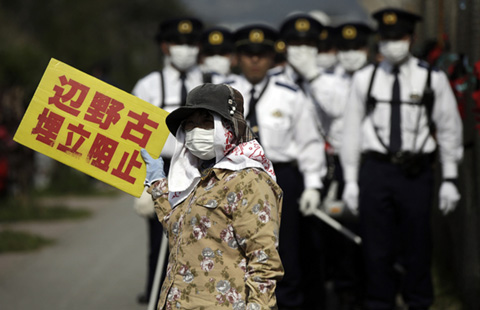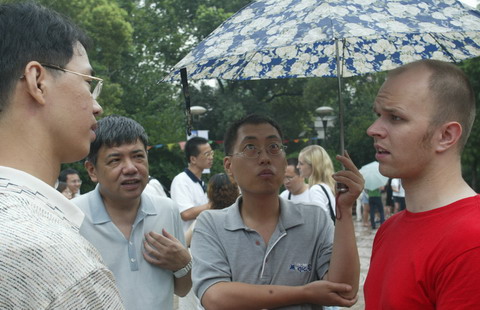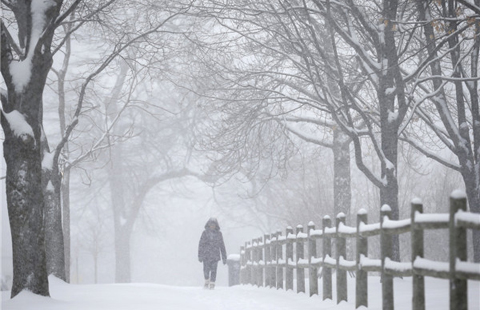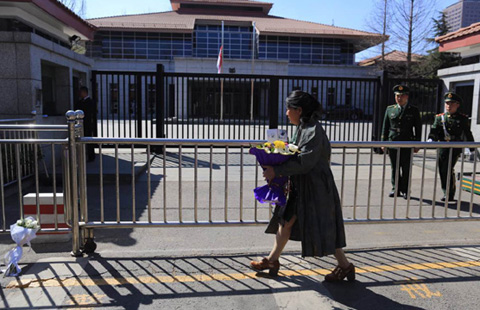$6.8b sea wall plan aims to beat tsunamis
Updated: 2015-03-23 07:54
By Associated Press in Sendai, Japan(China Daily)
|
||||||||
|
A Shinto shrine gate remains standing on a hill as sea walls are being built in the waterfront area in Rikuzentakata, Iwate Prefecture, northeastern Japan. [Eugene Hoshiko / AP] |
Four years after a tsunami ravaged much of Japan's northeastern coast, efforts to fend off future disasters are focusing on a 400-kilometer chain of sea walls, at places nearly five stories high.
Opponents of the 820 billion yen ($6.8 billion) plan argue that the massive concrete barriers will damage marine ecology and scenery, hinder vital fisheries and actually do little to protect residents who are mostly supposed to relocate to higher ground. Those in favor say the sea walls are a necessary evil; one that will provide some jobs, at least for a time.
The paradox of such projects, experts say, is that while they may reduce some damage, they can foster complacency. At least some of the 18,500 people who died or went missing in the 2011 disasters failed to heed warnings to escape in time.
Tsuneaki Iguchi was mayor of Iwanuma, a town just south of the region's biggest city, Sendai, when the tsunami triggered by a magnitude-9 earthquake just off the coast inundated half of its area.
A 7.2-meter-high sea wall built to help stave off erosion of the beaches slowed the wall of water, as did stands of tall, thin pine trees planted along the coast. But the tsunami still swept 5 km inland.
The city repaired the sea walls but doesn't plan to make them taller. Instead, Iguchi was one of the first officials to back a plan championed by former prime minister Morihiro Hosokawa to plant mixed forests along the coasts on tall mounds of soil or rubble, to help create a living "green wall".
"We don't need the sea wall to be higher. What we do need is for everyone to evacuate," Iguchi said. "The safest thing is for people to live on higher ground and for people's homes and their workplaces to be in separate locations. If we do that, we don't need to have a 'Great Wall'."
Some voices in unexpected places are urging a rethink of the plan.
Prime Minister Shinzo Abe's wife, Akie, offered numerous objections to cementing the northeast coast in a speech in New York last September.
"Please do not proceed even if it's already decided," she said. Instead of a one-size-fits-all policy, she suggested making the plan more flexible. "I ask, is building high sea walls to shield the coast line really, really the best?"
Rikuzentakata, a small city near Osabe whose downtown area was wiped out by the tsunami, is building a higher sea wall, and also raising the land well above sea level.

 Tokyo's plans to build new US base possibly scuppered
Tokyo's plans to build new US base possibly scuppered
 Conversation topics only heard in China
Conversation topics only heard in China
 Snow blankets Chicago after spring storm
Snow blankets Chicago after spring storm
 Dramatic changes for Chinese miners in the last 30 years
Dramatic changes for Chinese miners in the last 30 years
 Top 10 young Chinese entrepreneurs defining the future
Top 10 young Chinese entrepreneurs defining the future
 Singapore Embassy in Beijing mourns Lee Kuan Yew
Singapore Embassy in Beijing mourns Lee Kuan Yew
 China joins legendary flower show
China joins legendary flower show
 Monks perform tea-picking ritual in Hangzhou
Monks perform tea-picking ritual in Hangzhou
Most Viewed
Editor's Picks

|

|

|

|

|

|
Today's Top News
Plane crash in France kills 150, black box found
Iconic Chinese play hits America
Innovation is talk of summit on investment
China keen to invest in US
Beijing 'welcomes interested nations joining the AIIB'
House passes resolution urging Obama to send arms to Ukraine
US to strengthen cooperation on clean energy with China: Pritzker
Boston bomb suspect influenced by Al-Qaida
US Weekly

|

|








